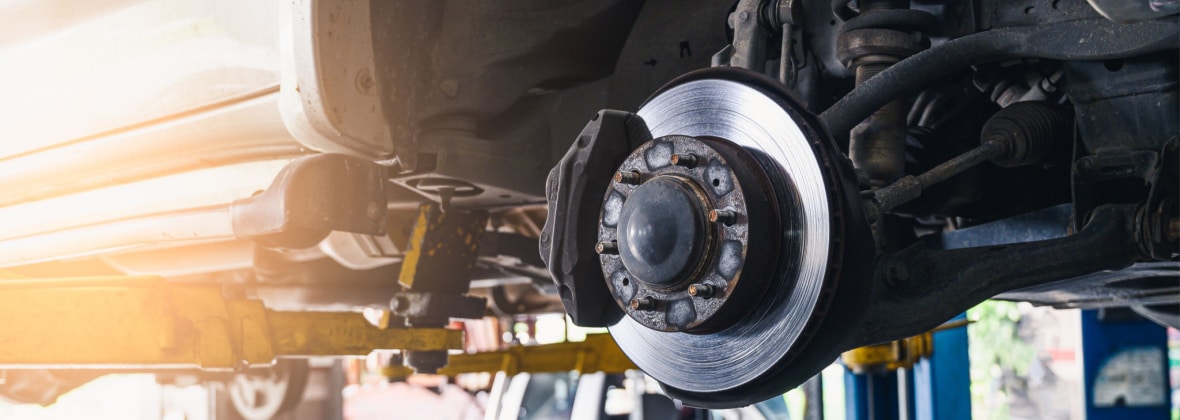What Brake Pads Are Best For My Ride? Simplify Brake Service At TIRECRAFT
October 17, 2022
Tires

To help you save money and get better results on your next brake service, today’s post explains the pros and cons of the three different types of brake pads: organic, metallic, and ceramic.
What’s best for your ride? Read on to find out, or contact your local TIRECRAFT to start a free consultation.
Brake Service 101: Choosing The Right Brake Pads For Your Ride
In a technical standard document titled Light Vehicle Brake Systems,Transport Canada sets strict performance and part requirements for brake systems in new vehicles, but no such regulations cover replacement brake pads.
Accordingly, it’s up to the consumer to choose what products and brake services are best for their vehicles. And that’s a complicated question. To answer it, you’ll need to know a bit about the three most common types of brake pads, and you’ll also need to think about which features matter most, since every design involves some degree of compromise.
For example, while one brake pad may offer superior heat transfer and braking performance, it may also be quite noisy, or leave excess brake dust on your rims, calipers and rotor. A different friction compound might give you a softer braking experience and quieter ride, in exchange for a shorter service life. For these reasons, there is no “best’ brake pad, but there is a “best-for-you,” and your local TIRECRAFT can help you find it.
To get you started, let’s talk a closer look at the three most common types of brake pads:
1. Organic brake pads—Organic brake pads come standard on about two-thirds of all new vehicles sold in Ontario today. They were once made from asbestos due to its heat-absorbing properties, but this material was replaced once its carcinogenic effects came to light. The newer “non-asbestos organic” (NAO) brake pads are made from a mixture of fibers and materials, such as fiberglass, rubber, carbon compounds, and in some cases, Kevlar, all of which are bound together with a special resin.
NAO brake pads are a popular choice during brake services because of their low price and the fact that they tend to produce less dust than metallic brakes. Organic brake pads are also relatively quiet; they only generate a moderate amount of friction; and they put very little stress on the brake rotors, which is a major plus, since those brake services can be quite costly. All of these benefits make organic brake pads a safe choice for most daily drivers.
That said, they do come with some disadvantages. Namely, organic brake pads take on wear rather quickly due to their composite nature, so you’ll need to plan for more regular replacements. They also aren’t the best in extreme weather, and their performance drops off when pushed too hard and allowed to overheat, as is often the case in heavy-hauling and performance driving situations.
In conclusion, if your driving needs are relatively basic, and you don’t put a ton of mileage on your vehicle, ask for NAO pads during your next brake service. You’ll save money upfront, and you’ll lift the burden off of your rotors, too.
2. Metallic brake pads—Metallic brake pads come in two varieties: full metal and semi-metallic, the former being reserved for the most extreme braking requirements.
Semi-metallic brake pads are made from a mix of metals and fillers, such as graphite lubricant, with most containing somewhere between 30% to 70% actual metal.
Metallic brake pads are typically used by drivers who value high-performance, and they perform well in a wide range of temperatures and conditions. They also withstand heat very well, and they compress less than organic alternatives, meaning you won’t have to “stomp on the brake” quite as much.
On the downside, metallic brakes are the noisiest of the three; they produce a lot of brake dust; and they put more stress on the brake rotors, which could increase your brake service costs over the long-term. In terms of pricing, metallic brakes sit right in the middle of the pack, costing more than organic brakes but less than ceramic compounds.
In conclusion, if you have a high-performance sports car, or you drive your car like one, metallic brakes will be a good fit. Metallic brakes are also great for drivers dealing with extreme temperatures.
3. Ceramic brake pads—Ceramic brakes are the most expensive of the three, but as with most things in life, you get what you pay for. Compared to metallic and organic brakes, they’re much quieter; they produce less brake dust as they wear down; and they perform well in a range of temperatures and conditions.
The main downside with ceramic brake pads is their cost, but they also cannot absorb quite as much heat as metallic brakes, which means the rest of your braking system will feel the strain in high-performance and emergency braking situations. They also aren’t the best option for extreme cold, so if you live in a particularly frigid part of Canada, metallic brake pads might be the better choice.
Simplify Brake Service: Contact Your Local TIRECRAFT
To learn more about what brake pads suit your vehicle, budget, and driving needs, get in touch with our brake service experts for a free consultation.
Back

